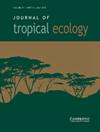退化热带干旱森林景观中树木的地下分化:没有证据表明存在协作梯度
IF 1
4区 环境科学与生态学
Q4 ECOLOGY
引用次数: 0
摘要
细根专门获取养分和水分,对物种的表现和生态系统的功能至关重要。最近的证据表明,与资源获取和资源保护相关的正交协作梯度和保护梯度分别决定了广阔的根系经济空间。然而,在根系生长受土壤条件限制的退化生态系统中生长的树种是否存在这些梯度还是一个未决问题。我们测量了在哥伦比亚热带干旱森林(TDF)退化牧场中共生生长9年的11种幼树的6个细根性状(根直径、比根长、根干物质含量、根组织密度、分枝强度和丛枝菌根定殖率),以确定(1)细根性状之间的共变性和(2)在相同土壤条件下共生的11种树种的地下生态位分化模式。细根性状之间的共变性类似于获得性-保守性,但不类似于这一退化栖息地的协作梯度。与协作梯度相关的一个关键特征--菌根定殖的百分比与任何细根特征都无关。此外,我们还发现物种之间存在强烈的地下分化,主要体现在根系直径和分枝强度上。我们的研究结果表明,TDF景观中压实的退化土壤可能会影响与菌根的协作关系,主要导致物种沿着 "自己动手 "梯度分化。这一发现提出了一个假设,需要用更多的物种和地点进行检验。我们讨论了利用根系特征帮助物种选择以达到恢复目的的重要性。本文章由计算机程序翻译,如有差异,请以英文原文为准。
Belowground differentiation among trees in a degraded tropical dry forest landscape: no evidence of a collaboration gradient
Fine roots are specialized in nutrient and water acquisition and are critical for species performance and ecosystem functioning. Recent evidence has shown a broad root economic space determined by the orthogonal collaboration and conservation gradients related to resource acquisition and resource conservation, respectively. However, whether these gradients exist among tree species growing in degraded ecosystems where root growth is limited by soil conditions is much an open question. We measured six fine root traits (root diameter, specific root length, root dry matter content, root tissue density, branching intensity, and percentage of arbuscular mycorrhizal colonization) in 11 young tree species growing in sympatry for 9 years in degraded pastures in a tropical dry forest (TDF) in Colombia to determine (1) the covariation between fine root traits and (2) the patterns of belowground niche differentiation among 11 species coexisting under the same soil conditions. The covariation between fine root traits resembled the acquisitive-conservative, but not the collaboration gradient for this degraded habitat. The percentage of mycorrhizal colonization, a critical trait associated with the collaboration gradient, was unrelated to any fine root trait. Furthermore, we found a strong belowground differentiation among species, mainly across root diameter and branching intensity. Our results suggest that compacted degraded soils in TDF landscapes may affect the collaborative association with mycorrhizae, mostly allowing species differentiation along the do-it-yourself gradient. This finding suggests a hypothesis that needs to be tested with more species and sites. We discuss the importance of using root traits to aid species selection for restoration purposes.
求助全文
通过发布文献求助,成功后即可免费获取论文全文。
去求助
来源期刊

Journal of Tropical Ecology
环境科学-生态学
CiteScore
2.10
自引率
0.00%
发文量
44
审稿时长
18-36 weeks
期刊介绍:
Journal of Tropical Ecology aims to address topics of general relevance and significance to tropical ecology. This includes sub-disciplines of ecology, such as conservation biology, evolutionary ecology, marine ecology, microbial ecology, molecular ecology, quantitative ecology, etc. Studies in the field of tropical medicine, specifically where it involves ecological surroundings (e.g., zoonotic or vector-borne disease ecology), are also suitable. We also welcome methods papers, provided that the techniques are well-described and are of broad general utility.
Please keep in mind that studies focused on specific geographic regions or on particular taxa will be better suited to more specialist journals. In order to help the editors make their decision, in your cover letter please address the specific hypothesis your study addresses, and how the results will interest the broad field of tropical ecology. While we will consider purely descriptive studies of outstanding general interest, the case for them should be made in the cover letter.
 求助内容:
求助内容: 应助结果提醒方式:
应助结果提醒方式:


